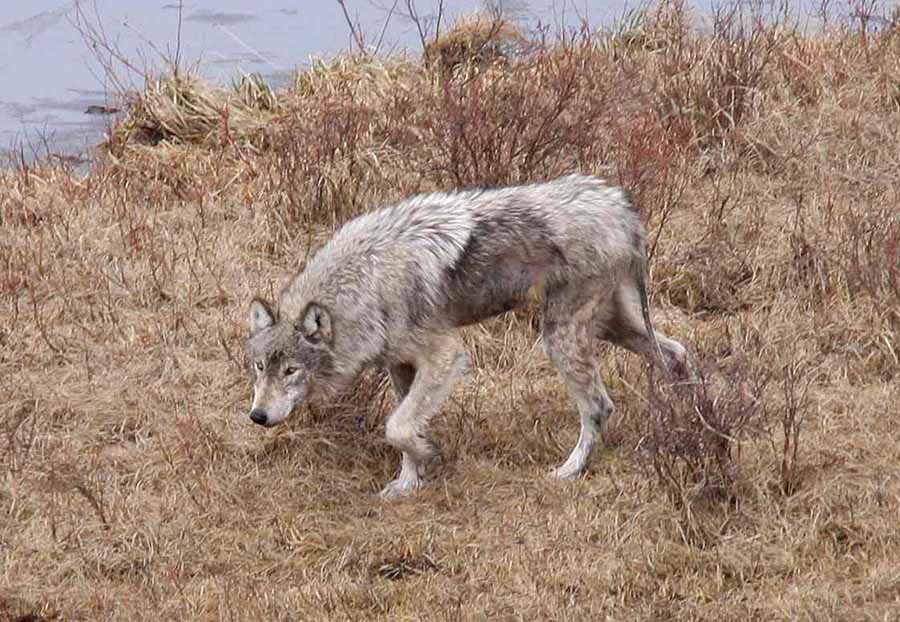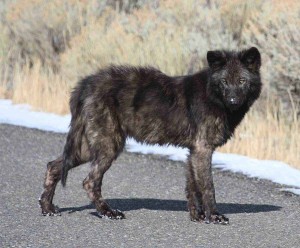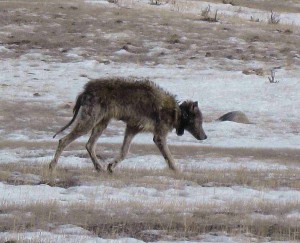
A researcher with the Yellowstone Wolf Project is raising money for a website that will collect and archive visitor photos to help track mange, an infectious disease that causes skin lesions and fur loss. (NPS file photo by Ryan Kindermann – click to enlarge)
By Ruffin Prevost
UPDATE: After Yellowstone Gate coverage of this Kickstarter project was reprinted in The Billings Gazette, National Parks Traveler, The Great Falls Prairie Star and in other publications, the campaign has been fully funded, exceeding its goal after only a few days.
The next time you visit Yellowstone National Park and manage to snap a great wolf photo, you could also be helping researchers as they monitor everything from infectious diseases to breeding habits among the elusive animals.
A Penn State University graduate student working on the Yellowstone Wolf Project has launched an Internet campaign to raise funds for a website that will let visitors upload wolf photos along with location information and other data. The goal is to track the spread and progress of sarcoptic mange among individual wolves and packs. But the effort could also prove helpful to other areas of wolf research.
Yellowstone wolf studies have long relied on field photos and images taken from research aircraft as important data sources, but scientists also sometimes use visitor photos to help answer questions about specific wolves.
A Kickstarter project video details how Yellowstone Park visitor photos will be used to aid in wolf research.
“We’ve found that the visitor photos have been incredibly helpful, and rather than searching for all of those on our own time, this would allow us to find and use them in a more organized way,” said Emily Almberg, who set up a Kickstarter campaign to raise $7,000 for a website that will solicit, organize and archive wolf photos.
The citizen science project will let visitors upload wolf photos, along with additional information such as where and when the picture was taken, what pack the wolf might belong to and any identifying marks, traits or other unique characteristics.

A wolf pup from the now-defunct Gardner Hole pack in Yellowstone National Park suffers from mange, a condition where mites cause excessive scratching resulting in fur loss. (NPS photo – click to enlarge)
Almberg has been working on the Yellowstone Wolf Project since 2003, and is hoping to use the photos to learn more about how mange is affecting Yellowstone’s wolves by recording fur loss and skin lesions as shown in the images.
Mange is caused when mites burrow into the skin of fur-bearing animals. In wolves, a reaction to the mites causes scratching which results in fur loss. Severe fur loss can leave wolves at risk of death from exposure to the cold.
A handful of researchers with the Yellowstone Wolf Project try to photograph or observe each of the park’s wolves on a monthly basis, especially those collared for research purposes, Almberg said. But there are more than 3 million annual visitors to the park, and most of them are carrying cameras and looking for wolves.
Many of the most active wolf-watchers know individual animals by sight, and often use high-end cameras with powerful lenses, Almberg said, so it makes sense to leverage their efforts in gathering data.
“There’s a community of people that spend anywhere from several days to months each year observing uncollared animals that the Wolf Project traditionally hasn’t tracked,” she said. “Those folks have a tremendous wealth of information that could be very helpful for research purposes.”

A collared female wolf from the former Leopold pack in Yellowstone National Park exhibits signs of a severe mange infection. Researchers are seeking visitor photos showing wolves with mange. (NPS photo – click to enlarge)
Photos gathered by the site could help in other areas of wolf research, ranging from tracking pack movements to sorting out relationship questions about specific breeding pairs, Almberg said.
Other online citizen science projects use similar crowdsourcing methods for everything from counting migrating birds to compiling historical weather records from archived ship logs.
While some park visitors will have only a vague idea of a photo’s location, some pro cameras can record GPS data with each shot. Almberg said the website will allow for public review and comments for each photo, leveraging the collective wisdom of the crowd to help verify data. Researchers will cross-reference images with their own data as part of verification, and exclude from final data sets any photos they aren’t confident about.
Visit the Yellowstone Wolf: Project Citizen Science page on Kickstarter for more information.
Pro photographers leery of sharing a prized image can upload a low-resolution version or have the photo blocked from public view.
Almberg said the website will be managed through Penn State, but that data will be shared with Wolf Project researchers and the public.
The campaign has already received more than $1,200 in pledges after five days, and runs through April 16. Almberg said a pilot website could be online sometime in May.
Contact Ruffin Prevost at 307-213-9818 or ruffin@yellowstonegate.com.

Is there any way to catch those wolves with mange and treat them?
Charlene,
While it might be logistically feasible to capture and treat wolves with mange, biologists view the disease as an inherent part of life for wolves and other fur-bearing animals. They typically try to let such processes run their course and not interfere. If it were to threaten the entire population in a serious way, I suppose that might be different. Also, it’s transmitted by contact with other wolves or animals infected with mites, so I think it would be difficult to prevent the spread of new cases even after treatment. In fact, some wolves are infected multiple times, because they don’t build up immunity to the mites as, for instance, humans do with chiken pox.
-Ruffin Prevost, editor
Yellowstone Gate
This happens when populations become to dense. The same thing happened to the fox in the Midwest when people stopped buying fur and hunters stopped hunting fox.
Thin them out, it will help.
Dear Ruffin,
Only in Yellowstone could one experience such a contradiction in policy. People are required to keep 100 yards from wolves. Furthermore, there are not enough paved turnouts in the park to facilitate the growing number of visitors. This solicited ‘bounty’ on the wolves only encourages stopping in the road or parking off the pavement and destroying natural vegetation. In the winter months, the limited number of turnouts are only partially plowed complicating the parking problems.
If people get too close to the wolves or stop in any of the “no stopping, no standing, no walking” sections of a given road, the posse canis lupus is on the radio to Rick McIntyre, who intern sicks the rangers on them via his NPS radio forcing the photographer/visitor to explain themselves.
Yellowstone justice equates to guilty as accused.
Steve Torrey
Cody, Wyo.